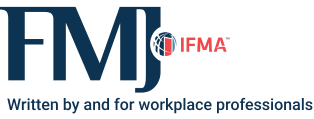Total Cost of Operations
4 steps toward a more comprehensive understanding

The facility operating environment has changed significantly over the past several years. Emerging hybrid work patterns continue to shift expectations around employees’ collective relationship with work. Organizations are understanding how the built world needs to evolve to empower the work to be done.
Global climate change and its associated challenges are driving environmental risk assessments for all infrastructure. Rising energy costs are requiring difficult conversations about how facility management professionals heat and cool their buildings in ways that ensure health and safety. Further, the rising price of construction and materials constrains an organization’s flexibility in fabricating its way to a new reality.
As these trends converge, FMs are challenged with reducing operating costs and identifying the most efficient and effective alternatives. To help an organization navigate the complex decisions related to optimizing the portfolio’s performance, FMs require current and accurate data, appropriate analysis frameworks and modern information systems to manage and curate that data. In addition to excellent reporting tools, they must also hone the communication competencies required to make their insights understood by various audiences.
Technology can help address each of these challenges in many areas. New data collection technologies make it faster and less expensive to capture detailed information about the location, condition, remaining useful life and performance of buildings and associated assets. Modern, cloud-based facility information systems are more powerful and easier to use on any device in and out of the office. Thanks to ever-improving integration capabilities, these applications can support what Gartner deems as composable enterprise information systems architecture. Increasingly, mechanical systems contain fi ne-grained sensor systems and can even self-report critical condition and performance metrics.
However, FMs know that technology alone can never fully solve business problems. Solutions must be organized within the appropriate business processes and managed by agile teams who know what they are doing. To this end, industry standards can be beneficial in establishing best practices and recommending the types of training individuals within the organization will need to be effective.
The APPA Total Cost of Ownership (TCO) 1000 standards are a prime example of documentation that can assist an organization along its journey of understanding— ultimately optimizing one’s buildings and infrastructure operations. By combining this with other international standards, such as ISO 55000, FM professionals can better understand, document and manage the TCO for their portfolio. It is helpful to remember that maintenance and operations comprise more than 80 percent of the total cost of ownership. Therefore, FMs have tremendous control over reducing costs and optimizing their facilities’ performance. To be effective in this effort requires planning, insightful analysis and timely investments in the context of an overall programmatic approach.
FMs can get a more comprehensive view of their total cost of ownership with four key steps.
|
1. Start with clear & consistent data
Any programmatic approach to optimizing one’s total cost of ownership must be based on current, accurate and complete data. Before the portfolio can be managed, it must first be understood. An asset inventory is essential to begin the journey.
FOOD FOR THOUGHT: How many facility assets does the company have? Where are they located? What is their condition? What is their remaining useful life? What is the backlog of deferred maintenance on those assets? Where are the most significant concentrations of business-critical risk?
Location is a critical element of the asset inventory. Where an asset is located influences how suitable it is to serve the organization’s mission, identifies potential opportunities for expansion or consolidation, and affects exposure to different risk elements. Assets on the north and south sides of a building will often perform differently. Proximity to amenities such as collaboration spaces, food and parking will make some buildings and spaces more valuable than others.
Creating a new asset inventory from scratch can be intimidating for facility management professionals. Depending on the size of an FM’s organization, they may want to collect thousands to hundreds of thousands of assets. At the same time, they must always keep quality in mind. The only thing worse than no data is incomplete, inaccurate or out-of-date data.
FM leaders must manage expectations and capture what they can confidently keep current amid ongoing business practices. Once good data management practices are in place, they should start at a high level and add granularity and specificity as needed.
Outside contractors can be a great way to start an asset inventory. Hiring an outside consulting firm to perform a facilities condition assessment (FCA) can deliver many benefits. Consultants can be excellent partners as they have:
-
Engineering professionals on staff, specially trained to evaluate facilities assets. Engineering assessments are their primary business, so their experience, perspective and lessons learned are pretty valuable.
-
Refined data collection tools and proven methodologies. Streamlined processes enable them to collect the data more quickly and consistently than an in-house FM team may be able to do themselves.
-
Resources to capture complementary data sets at one time. With access to the latest mobile LiDAR or photogrammetry data collection platforms, firms can collect floor plans, spherical images and other deliverables in the process of an FCA. These supporting data sets can be tremendously valuable tools in managing a portfolio.
Whether a team conducts its FCAs with in-house resources or hires a consultant, a solid asset inventory is a critical cornerstone of any asset management program. This includes information about replacement costs, remaining useful life, deferred maintenance and current conditions.
|
2. Measure what matters
If an FM’s primary objective is to understand and manage the total cost of operations, it is essential to capture the critical elements of operational costs. For most organizations, the most significant components of operating expenses will include energy, maintenance, janitorial and lease costs. Often this data comes from other software solutions.
-
Energy: Energy information may come from energy management and utility billing software. These solutions analyze energy bills at the meter level and provide analysis of monthly costs, consumption trends and local weather correlations. They can also identify anomalous patterns and report an organization’s carbon footprint or other associated greenhouse gas emissions. For most organizations, energy costs will make up more than 15 percent of their overall operating costs.
-
Maintenance: The most likely source of ongoing maintenance costs will be the organization’s computerized maintenance management system (CMMS) or an integrated workplace management system (IWMS), sometimes known as an operations management system or facility management system. Properly implemented, these systems provide information about asset-specific maintenance cost histories, trends, asset conditions and deferred maintenance backlogs. This information is critical to understanding where there might be concentrations of business risk exposure and to help prioritize asset investments to improve the performance of the overall asset base.
-
Janitorial: Depending on whether the janitorial function is done with in-house resources or contracted to outside firms, per-building janitorial costs may come from one’s maintenance management system or an enterprise resource planning (ERP) solution. Regardless of the system of record for janitorial expenses, these costs should be periodically reconciled with information from an organization’s space information system to ensure that cost patterns align with overall rooms and floor area being maintained by room type and flooring type.
-
Lease: Lease expenses may come directly from one’s ERP solution or sometimes from a bespoke lease management system. Regardless of the source, basic information about lease type, lease period and ancillary costs—e.g., utilities, janitorial, parking—that may be covered by the lease will need to be periodically reviewed. This will ensure that the organization takes advantage of opportunities to drive the most value possible from its lease footprint.
|
3. Enable deeper analysis with integrations
One of the most important milestones in the TCO management journey is integrating, aggregating and reconciling information from multiple sources to enable more profound analysis, reporting and actionable insights. When categorized cost data is combined with space and occupancy data, valuable metrics can be developed, such as cost per square foot, cost per occupant, revenue per square foot and revenue per occupant.
These cost indices can allow FMs to benchmark performance metrics across the portfolio. The more granular the data, the more interesting the analyses one can support. It is also essential to ensure that data is collected with sufficient frequency to answer the questions about temporal variation critical to understanding optimization opportunities.
4. Ask the right questions for valuable insights
The character of each organization and the nature of its portfolio are different. Therefore, the kinds of questions that are most important to ask and answer will differ per organization. For some, a driving priority may be understanding how to reduce overall energy consumption to meet the organization’s carbon footprint goals. For this analysis, understanding how energy consumption varies with occupancy patterns throughout the day, week, month and season can help drive building system management plans that reduce overall energy consumption.
|
For other organizations, increasing overall research productivity may be the driving priority. In this case, understanding which spaces are suitable for different research activities and which researchers are most productive is key. Other organizations may focus on identifying which buildings have the highest concentrations of operational cost and deferred maintenance to prioritize building decommissioning and reduce the overall size of the portfolio.
Bottom line: Optimizing TCO requires good data and integrated systems
In today’s dynamic business environment, FMs have a growing influence in the discussion about reducing overall portfolio costs while ensuring that the business has the best foundation to deliver on its mission. To deliver on this opportunity, facility teams must work hard to ensure they have complete, accurate and current data at sufficient granularity to answer the key optimization questions.
Once a solid facilities data foundation is established, that data can be integrated with complementary systems to deliver actionable insights. It is essential to recognize that this vision is a journey, not a destination. The perfect system will never exist. One can always do better today than one did yesterday. If facilities professionals make sufficient investments in the right plan, their overall value to the organization will continue to improve.

Stu Rich is an industry lead at Cartegraph where he leverages nearly two decades of experience to help facility management professionals build higher-performing building and infrastructure operations. Previously, Rich served as the CTO of PenBay Solutions. There, he led the team that published the first Buildings Interior Spatial Data Model (BISDM) as an open-source data model project for organizations interested in modeling their buildings in GIS.
Read more on Real Estate and Finance & Business or related topics Cost Savings , Energy and Financial Analysis
Explore All FMJ Topics






 Food for Thought
Food for Thought


